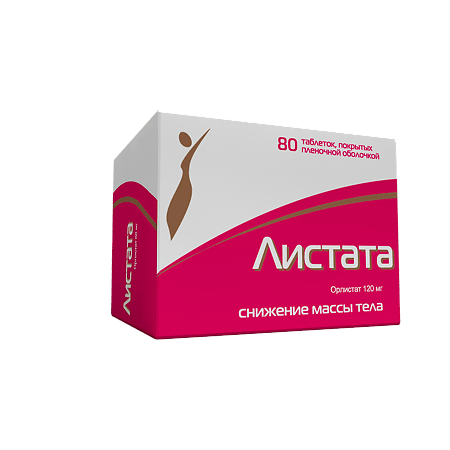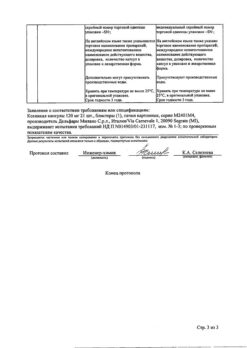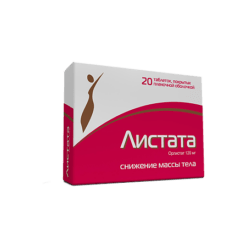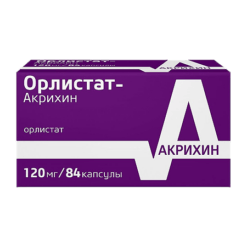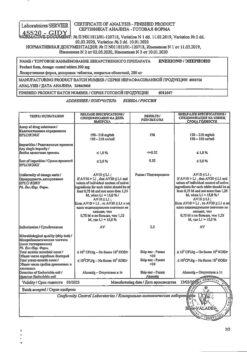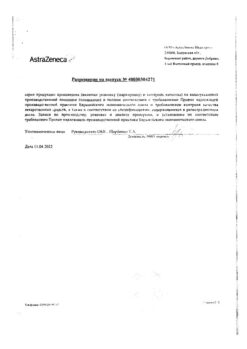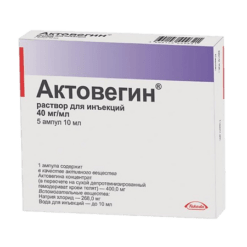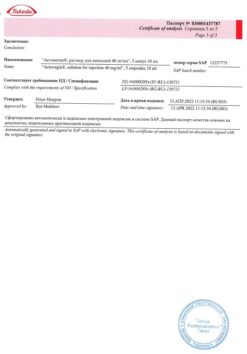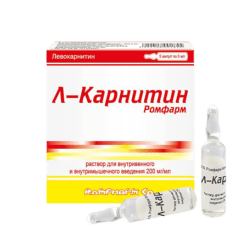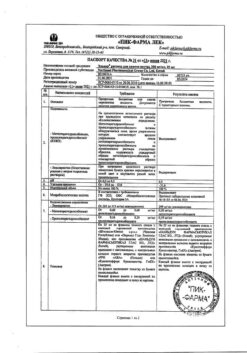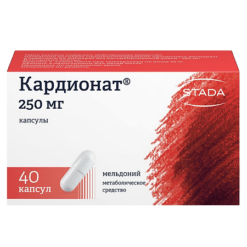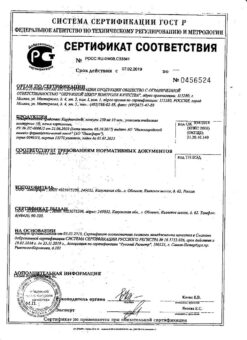No products in the cart.
Listata, 120 mg 80 pcs
€80.98 €67.48
Description
Pharmacodynamics.
Orlistat is a potent, specific and reversible inhibitor of gastrointestinal lipases with prolonged action. Its therapeutic action is carried out in the lumen of the stomach and small intestine and consists in formation of covalent bonding with the active serine site of gastric and pancreatic lipases.
Inactivated enzyme in this case loses the ability to break down food fats coming in the form of triglycerides into absorbable free fatty acids and monoglycerides.
Since unrepaired triglycerides are not absorbed, the resulting decrease in caloric intake into the body leads to a decrease in body weight.
Thus the therapeutic effect of the drug is carried out without absorption into the systemic blood flow. Judging by the results of fecal fat content, the action of orlistat begins 24-48 hours after intake. After discontinuation of orlistat the content of fat in feces in 48-72 hours usually returns to the level before the beginning of therapy.
Clinical efficacy. Patients taking orlistat show greater weight loss compared to patients on diet therapy.
The weight loss begins within the first 2 weeks of starting treatment and continues for 6 to 12 months, even in patients with a negative response to diet therapy. Over 2 years there is a statistically significant improvement in the profile of metabolic risk factors associated with obesity.
In addition, there is a significant reduction in body fat compared to placebo administration. Orlistat is effective in preventing weight gain again.
Re-gain of body weight, no more than 25% of that lost, is observed in about half of the patients, and half of these patients have no re-gain of body weight or even further weight loss is noted.
Overweight or obese patients with type 2 diabetes mellitus taking orlistat for 6 months to 1 year have greater weight loss compared with patients receiving diet therapy alone.
Weight loss is mainly due to a decrease in body fat. During orlistat therapy a statistically and clinically significant improvement in glycemic control is observed. In addition, against the background of orlistat therapy there is a decrease in the dose of hypoglycemic agents, insulin concentration, as well as a decrease in insulin resistance.
Orlistat use for 4 years significantly reduces the risk of type 2 diabetes mellitus (by about 37% compared to placebo). The degree of risk reduction is even greater in patients with baseline impaired glucose tolerance (about 45%).
Maintenance of body weight at a new level is observed during the entire period of the drug administration. When orlistat is used for 1 year in adolescents with obesity the decrease of BMI, fat mass as well as waist and hip circumference is observed as compared to the placebo group.
Also, patients treated with orlistat showed a significant decrease in diastolic BP compared to the placebo group.
Indications
Indications
Long-term therapy of obese patients with a BMI of at least 30 kg/m2 or overweight patients with a BMI of at least 28 kg/m2, incl. having risk factors associated with obesity, in combination with a moderately hypocaloric diet; in combination with hypoglycemic drugs (metformin, sulfonylurea derivatives and/or insulin) and/or a moderately hypocaloric diet in patients with type 2 diabetes mellitus who are overweight or obese.
Pharmacological effect
Pharmacological effect
Pharmacodynamics.
Orlistat is a potent, specific and reversible inhibitor of gastrointestinal lipases with a long-lasting effect. Its therapeutic effect occurs in the lumen of the stomach and small intestine and consists of the formation of a covalent bond with the active serine site of gastric and pancreatic lipases.
The inactivated enzyme then loses the ability to break down food fats, which come in the form of triglycerides, into absorbable free fatty acids and monoglycerides.
Since unsplit triglycerides are not absorbed, the resulting decrease in caloric intake into the body leads to a decrease in body weight.
Thus, the therapeutic effect of the drug is carried out without absorption into the systemic circulation. Based on fecal fat results, the effects of orlistat begin 24 to 48 hours after dosing. After discontinuation of orlistat, fecal fat content usually returns to pre-therapy levels within 48-72 hours.
Clinical effectiveness. Patients taking orlistat experience greater weight loss compared to patients on diet therapy.
Body weight loss begins within the first 2 weeks after the start of treatment and continues from 6 to 12 months, even in patients with a negative response to diet therapy. Over the course of 2 years, there was a statistically significant improvement in the profile of metabolic risk factors associated with obesity.
In addition, compared to placebo, there was a significant reduction in body fat. Orlistat is effective in preventing weight gain.
Re-gain of body weight, no more than 25% of lost, is observed in approximately half of the patients, and in half of these patients, re-gain of body weight is not observed or even a further decrease is observed.
Overweight or obese patients with type 2 diabetes mellitus treated with orlistat for 6 months to 1 year experienced greater weight loss compared with patients receiving dietary therapy alone.
Weight loss occurs mainly due to a decrease in the amount of fat in the body. With orlistat therapy, a statistically and clinically significant improvement in glycemic control is observed. In addition, during therapy with orlistat, there is a decrease in the dose of hypoglycemic agents, insulin concentration, as well as a decrease in insulin resistance.
When using orlistat for 4 years, the risk of developing type 2 diabetes mellitus is significantly reduced (by approximately 37% compared to placebo). The degree of risk reduction is even greater in patients with baseline impaired glucose tolerance (approximately 45%).
Maintaining body weight at a new level is observed throughout the entire period of use of the drug. When orlistat was used for 1 year in obese adolescents, a decrease in BMI, a decrease in fat mass, and a decrease in waist and hip circumference was observed compared with the placebo group.
Also, patients treated with orlistat showed a significant decrease in diastolic blood pressure compared to the placebo group.
Special instructions
Special instructions
Listata is effective in long-term weight control (weight loss and maintenance, prevention of weight gain).
Treatment with Listata leads to an improvement in the profile of risk factors and diseases associated with obesity, including hypercholesterolemia, type 2 diabetes mellitus, impaired glucose tolerance, hyperinsulinemia, arterial hypertension, and a decrease in the amount of visceral fat.
When used in combination with hypoglycemic drugs such as metformin, sulfonylurea derivatives and/or insulin in patients with type 2 diabetes mellitus with overweight (BMI of at least 28 kg/m2) or obesity (BMI of at least 30 kg/m2), Listata in combination with a moderately hypocaloric diet further improves the compensation of carbohydrate metabolism.
In clinical studies, the majority of patients had concentrations of vitamins A, D, E, K and beta-carotene within the normal range during 4 years of orlistat therapy. Multivitamins can be taken to ensure adequate intake of all minerals.
The patient should receive a balanced, moderately hypocaloric diet containing no more than 30% of calories in the form of fat. A diet rich in fruits and vegetables is recommended. The daily intake of fats, carbohydrates and proteins must be divided into three main meals.
The likelihood of adverse reactions from the gastrointestinal tract may increase if Listata is taken on a diet rich in fat (for example, 2000 kcal/day, of which more than 30% in the form of fat, which equals approximately 67 g of fat).
If Listata is taken with a meal very rich in fat, the likelihood of gastrointestinal reactions increases. In patients with type 2 diabetes mellitus, weight loss during treatment with Listata is accompanied by improved compensation of carbohydrate metabolism, which may allow or require a reduction in the dose of hypoglycemic drugs (for example, sulfonylurea derivatives).
Impact on the ability to drive vehicles and machinery.
Listata does not affect the ability to drive vehicles and machines. Patients with type 2 diabetes mellitus using Listata in combination with hypoglycemic drugs should be careful when driving vehicles and machinery due to the possible development of hypoglycemia, accompanied by dizziness and blurred vision.
Active ingredient
Active ingredient
Orlistat
Contraindications
Contraindications
Hypersensitivity sensitivity to orlistat or any other components of the drug; chronic malabsorption syndrome; cholestasis; pregnancy, breastfeeding period; children’s age up to 12 years.
Side Effects
Side Effects
Clinical trial data.
Side effects of the drug are systematized in relation to each organ system depending on the frequency of occurrence, using the following classification: very often (more than 1/10); often (more than 1/100, less than 1/10); uncommon (more than 1/1000, less than 1/100); rare (more than 1/10,000, less than 1/1000); very rare, including isolated messages (less than 1/10,000).
Adverse reactions when using orlistat occurred mainly from the gastrointestinal tract and were due to the pharmacological effect of orlistat, which interferes with the absorption of dietary fats.
Very often, phenomena such as oily discharge from the rectum, the release of gases with some discharge, an imperative urge to defecate, steatorrhea, increased frequency of bowel movements, loose stools, flatulence, pain or discomfort in the abdomen were noted.
Their frequency increases with increasing fat content in food. Patients should be informed of the possibility of gastrointestinal adverse reactions and taught how to manage them with diet, especially in relation to the amount of fat it contains.
The use of a low-fat diet reduces the likelihood of side effects from the gastrointestinal tract and thereby helps patients control and regulate their fat intake. As a rule, these adverse reactions are mild and transient.
They occur in the early stages of treatment (in the first 3 months), and most patients had no more than one episode of such reactions. When treating with orlistat, the following adverse events from the gastrointestinal tract often occur: “soft” stools, pain or discomfort in the rectum, fecal incontinence, bloating, dental damage, gum damage.
Also noted very often were headaches, upper respiratory tract infections, flu; often – lower respiratory tract infections, urinary tract infections, dysmenorrhea, anxiety, weakness. In patients with type 2 diabetes mellitus, the nature and frequency of adverse events were comparable to those in overweight and obese individuals without diabetes mellitus.
The only new adverse events in patients with type 2 diabetes mellitus were hypoglycemic conditions, occurring with an incidence of more than 2% and an incidence of at least 1% compared with placebo (which may have resulted from improved compensation of carbohydrate metabolism), and frequently, abdominal bloating.
In the 4-year clinical study, the overall safety profile did not differ from that obtained in the 1- and 2-year studies. At the same time, the overall incidence of adverse events from the gastrointestinal tract decreased annually over the 4-year period of taking the drug.
Post-marketing surveillance. Rare cases of allergic reactions have been described, the main clinical manifestations of which were skin rash, itching, urticaria, angioedema, bronchospasm and anaphylaxis.
Very rare cases of bullous rash, increased activity of transaminases and alkaline phosphatase, as well as isolated, possibly serious cases of hepatitis have been described (a cause-and-effect relationship with taking orlistat or pathophysiological mechanisms of development have not been established).
With the simultaneous use of orlistat with indirect anticoagulants, cases of decreased prothrombin, increased international normalized ratio (INR) values, and unbalanced anticoagulant therapy have been reported, which led to changes in hemostatic parameters.
Cases of rectal bleeding, diverticulitis, pancreatitis, cholelithiasis and oxalate nephropathy have been reported (incidence unknown). When taking orlistat and antiepileptic drugs simultaneously, cases of seizures have been observed (see section “Interaction with other drugs”).
Interaction
Interaction
There was no interaction of orlistat with amitriptyline, atorvastatin, biguanides, digoxin, fibrates, fluoxetine, losartan, phenytoin, oral contraceptives, phentermine, pravastatin, warfarin, nifedipine GITS (gastrointestinal therapeutic system) and nifedipine slow release, sibutramine or ethanol (based on drug interaction studies).
However, it is necessary to monitor INR values during simultaneous therapy with warfarin or other indirect anticoagulants. When taken simultaneously with orlistat, a decrease in the absorption of vitamins D, E and beta-carotene was observed.
If multivitamins are recommended, they should be taken at least 2 hours after taking orlistat or at bedtime. When taking orlistat and cyclosporine together, a decrease in the concentration of cyclosporine in the blood plasma was observed, therefore, more frequent determination of the concentration of cyclosporine in the blood plasma is recommended when taking cyclosporine and orlistat simultaneously.
When amiodarone was taken orally during orlistat therapy, a decrease in the systemic exposure of amiodarone and desethylamiodarone was observed (by 25-30%), however, due to the complex pharmacokinetics of amiodarone, the clinical significance of this phenomenon is not clear.
Adding orlistat to long-term amiodarone therapy may result in a decrease in the therapeutic effect of amiodarone (no studies have been conducted). Concomitant use of orlistat and acarbose should be avoided due to the lack of pharmacokinetic study data.
Cases of seizures have been observed when taking orlistat and antiepileptic drugs simultaneously.
A cause-and-effect relationship between the development of seizures and orlistat therapy has not been established. However, patients should be monitored for possible changes in seizure frequency and/or severity.
Overdose
Overdose
In individuals with normal body weight and obese patients, single doses of 800 mg or repeated doses of orlistat 400 mg 3 times a day for 15 days were not accompanied by the occurrence of significant adverse events.
In addition, obese patients have experience using orlistat 240 mg 3 times a day for 6 months, which was not accompanied by a significant increase in the incidence of adverse events.
In cases of orlistat overdose, either no adverse events were reported, or the adverse events did not differ from those observed when taking orlistat in therapeutic doses. In case of severe overdose of orlistat, it is recommended to observe the patient for 24 hours.
Based on human and animal studies, any systemic effects that could be attributed to the lipase inhibitory properties of orlistat should be rapidly reversible.
Manufacturer
Manufacturer
Izvarino Pharma, Russia
Additional information
| Manufacturer | Izvarino Pharma, Russia |
|---|---|
| Medication form | pills |
| Brand | Izvarino Pharma |
Other forms…
Related products
Buy Listata, 120 mg 80 pcs with delivery to USA, UK, Europe and over 120 other countries.

